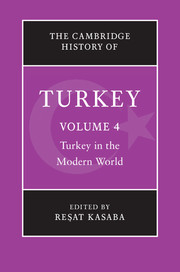Book contents
- Frontmatter
- 1 Introduction
- PART I OTTOMAN BACKGROUND AND TRANSITION
- PART II REPUBLIC OF TURKEY
- 7 Migration and Turkey: the dynamics of state, society and politics
- 8 The migration story of Turks in Germany: from the beginning to the end
- 9 Politics and political parties in Republican Turkey
- 10 Economic change in twentieth-century Turkey: is the glass more than half full?
- 11 Ideology, context and interest: the Turkish military
- 12 Kurds and the Turkish State
- 13 Islam and politics in contemporary Turkey
- 14 Sufism and Islamic groups in contemporary Turkey
- 15 Contestation and collaboration: women’s struggles for empowerment in Turkey
- 16 Art and architecture in modern Turkey: the Republican period
- 17 The novel in Turkish: narrative tradition to Nobel prize
- 18 A brief history of modern Istanbul
- Select bibliography
- Index
- References
10 - Economic change in twentieth-century Turkey: is the glass more than half full?
from PART II - REPUBLIC OF TURKEY
Published online by Cambridge University Press: 28 November 2009
- Frontmatter
- 1 Introduction
- PART I OTTOMAN BACKGROUND AND TRANSITION
- PART II REPUBLIC OF TURKEY
- 7 Migration and Turkey: the dynamics of state, society and politics
- 8 The migration story of Turks in Germany: from the beginning to the end
- 9 Politics and political parties in Republican Turkey
- 10 Economic change in twentieth-century Turkey: is the glass more than half full?
- 11 Ideology, context and interest: the Turkish military
- 12 Kurds and the Turkish State
- 13 Islam and politics in contemporary Turkey
- 14 Sufism and Islamic groups in contemporary Turkey
- 15 Contestation and collaboration: women’s struggles for empowerment in Turkey
- 16 Art and architecture in modern Turkey: the Republican period
- 17 The novel in Turkish: narrative tradition to Nobel prize
- 18 A brief history of modern Istanbul
- Select bibliography
- Index
- References
Summary
Introduction
One metaphor for assessing Turkey’s economic performance in the twentieth century may be to ask whether the glass is half full or half empty. On the one hand, Turkey has experienced far-reaching economic changes since the early 1920s. The primarily rural and agricultural economy of the early twentieth century has transformed into a mostly urban economy. Average or per capita incomes have increased more than fivefold during this period. Other indicators of standards of living have also improved significantly. Life expectancy at birth has almost doubled from under thirty-five years in the interwar era to sixty-nine years. Adult literacy rates have increased from about 10 per cent to about 90 per cent (see table 10.1).
On the other hand, it would be misleading to judge economic performance only in absolute terms. The twentieth century, especially its second half, was a period of rapid increases in the standards of living in most parts of the developing world, of which Turkey is still considered a part. Increases in per capita incomes in Turkey since the First World War have been close to, but slightly above, world averages and averages for the developing countries. The income per capita gap between Turkey and the high-income countries of Western Europe and North America was about the same in 2005 as it was on the eve of the First World War. Certainly, Turkey has not been one of the miracle-producing economies of the twentieth century.
- Type
- Chapter
- Information
- The Cambridge History of Turkey , pp. 266 - 300Publisher: Cambridge University PressPrint publication year: 2008
References
- 18
- Cited by



